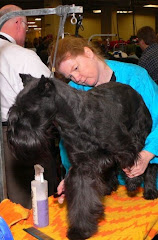There's More to Grooming that Just Trimming Hair: Your Dog's Health and Happiness Requires Regular Maintenance Between Trips to the Groomer
Whether you groom your dog yourself or take it to a professional to be groomed, there are certain grooming tasks that must be done more often than every two or three months. Eyes, ears, teeth, feet and nails, as well as the coat, require regular attention.
To help keep your dog clean, comfortable and healthy, these little steps should ideally be performed weekly or daily; but even just a few times between full groomings is better than not at all.
Given a choice, dogs would forego grooming altogether. Being groomed requires the dog to relinquish control and trust its body to you. This is the primary reason they fight it and one of the most compelling reasons they need to learn to tolerate it. There are steps you can take to make it as easy as possible for you and the dog to build the right kind of non-adversarial grooming relationship.
Grooming should be done on a raised surface like a grooming table or your washer/dryer with a non-slip mat on it. This takes the dog out of his normal territory and into yours. Lucky is the person who can successfully groom their dog on the floor.
If you don’t have a grooming table with a noose, be sure the dog is wearing a collar and leash so you can control it more easily. If you can anchor the dog in place, it helps you have both hands free (this is why a grooming table with a noose is of such benefit). The leash and collar also give some context about who is in charge (hopefully you).
When you are finished with grooming, lift the dog down rather than let it jump. That way it never comes to think of jumping down as a way to escape. As you lower the dog to the floor, do not allow it to squirm and twist out of your arms. Do not let the dog go until it has relaxed (relatively) in your arms. Emphasize that YOU are in control!
GAINING THE WINNER'S EDGE FOR YOUR SHOW DOG COMPANION
With close attention to details and some good coaching and assistance, you and your dog can both be winners, too. Here are suggestions that will help.
Subscribe to:
Post Comments (Atom)


.jpg)
No comments:
Post a Comment